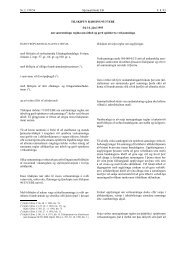Nomination of
Nomination of
Nomination of
You also want an ePaper? Increase the reach of your titles
YUMPU automatically turns print PDFs into web optimized ePapers that Google loves.
SURTSEY – NOMINATION FOR THE UNESCO WORLD HERITAGE LIST<br />
Stórhöfði and Sæfell-Helgafell on the island <strong>of</strong><br />
Heimaey. Two volcanic eruptions are known with<br />
certainty in historic times: the Surtsey eruption <strong>of</strong><br />
1963–1967 and the 1973 Eldfell eruption on<br />
Heimaey. A small submarine eruption may have<br />
occurred on the sea floor southeast <strong>of</strong> Hellisey in<br />
1896. Furthermore, four young submarine<br />
volcanoes have been discovered, so that<br />
altogether 24 volcanic eruptions are known to<br />
have occurred within the Vestmannaeyjar system<br />
during the Holocene (Sveinn P. Jakobsson 1979).<br />
In addition to the submarine rises produced by<br />
the Holocene eruptions, numerous hills and<br />
peaks on the sea floor (Fig. 2.4) presumably<br />
represent remnants <strong>of</strong> more than 40 Late-<br />
Pleistocene submarine volcanoes. Most <strong>of</strong> the<br />
volcanoes in the Vestmannaeyjar system are<br />
relatively small.<br />
As a large part <strong>of</strong> the Vestmannaeyjar volcanic<br />
system is submarine, its geographical limits are<br />
difficult to delineate exactly; however, it reaches<br />
about 38 km from southwest to northeast and 29<br />
km from northwest to southeast, covering an area<br />
<strong>of</strong> 900–1000 km 2 , where the average depth <strong>of</strong> the<br />
Aerial view to the southwest <strong>of</strong> the Vestmannaeyjar<br />
archipelago. Elliðaey and Bjarnarey are in the<br />
foreground, Heimaey in the middle and Surtsey in the<br />
far background. (Photo: Ragnar Th. Sigurðsson 2000).<br />
14<br />
sea is about 70 m. The volume <strong>of</strong> volcanic rock<br />
extruded within the Vestmannaeyjar volcanic<br />
system during the Holocene period has been<br />
estimated as ≥ 3.5 km 3 , which is one order <strong>of</strong><br />
magnitude less than the output <strong>of</strong> the highly<br />
active Hekla and Katla volcanic systems.<br />
Investigations on the Vestmannaeyjar shelf<br />
(Sveinn P. Jakobsson 1982; Kjartan Thors and<br />
Jóhann Helgason 1988) indicate that local<br />
submarine as well as subaerial volcanism was the<br />
source <strong>of</strong> the material building up the marine<br />
shelf and that for the most part this build-up has<br />
probably been ongoing for the last 100,000 years.<br />
The main activity in the Vestmannaeyjar<br />
volcanic system has occurred in and around<br />
Heimaey (Fig. 2.4), which has accordingly<br />
formed a topographic high. Indeed, it has been<br />
proposed that Heimaey is evolving into a central<br />
volcano (Sveinn P. Jakobsson 1979). On the other<br />
hand, there are strong indications that<br />
Vestmannaeyjar system volcanism is episodic.<br />
The youngest Late-Pleistocene tuffs and lavas <strong>of</strong><br />
the Norðurklettar Formation seem to have all<br />
been deposited within a short time interval. There<br />
also appears to have been a major volcanic<br />
episode 5,000–6,000 years ago, leading to the<br />
formation <strong>of</strong> Stórhöfði and Helgafell on Heimaey







![Aðalnámskrá tónlistarskóla : rytmÃsk tónlist [Eingöngu á rafrænu formi]](https://img.yumpu.com/50843672/1/184x260/aaalnamskra-tanlistarskala-rytma-sk-tanlist-eingangu-a-rafranu-formi.jpg?quality=85)









